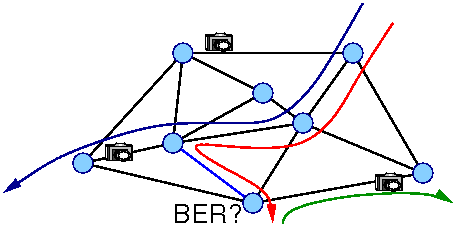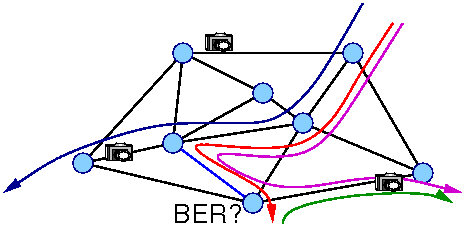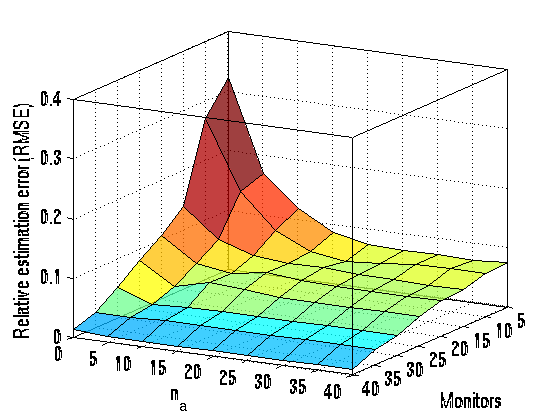|
Researchers: Yvan Pointurier, Postdoc, Prof. Mark Coates & Prof. Mike Rabbat
Description:
We propose a Quality of Transmission (QoT) monitoring technique for all-optical networks that uses a limited amount of hardware monitoring equipment.
Monitoring QoT, which can be measured through Bit-Error Rates, is important because network clients are typically guaranteed a minimum service which must provided by the network
The QoT of unobserved lightpaths that are not directly measured by monitoring equipment is estimated rather than measured. This is done by using the knowledge of the network state (the routing matrix), and by establishing new, "active lightpaths". We gain additional information about the unobserved lightpaths by measuring the QoT of the carefully chosen active lightpaths.
Our method consists in two main components. We propose an active lightpath selection algorithm adapted to the estimation problem in all-optical networks.
Then, we adapt a published estimation algorithm to the problem of monitoring in all-optical networks in order to estimate the QoT of all lightpaths established in the network, including those for which measurements by hardware monitors are not available. Our technique is backed by simulations, which demonstrate the possibility to reduce the number of hardware monitoring equipment while still achieving accurate monitoring.
How does it work:
Suppose we have this network (see below) where 3 lightpaths are established, two of which are observed by the hardware BER monitors represented by small cameras - the dark blue lightpath, and the green lightpath. The red lightpath is not observed: we do not know its BER! We are able to know partial information about the first two links of the red lightpath via the blue lightpath, but we cannot know anything about the last link, in lighter blue.
The problem is to determine the BER for the red lightpath. Of course, we could add hardware monitors in the network, but this is very expensive. We can actually estimate the BER of the red lightpath at almost no cost.

Our solution consists in establishing carefully engineered additional lightpaths, called "active lightpaths", to gather information about unobserved lightpaths and links. Here, for instance, we establish the purple lightpath. The active lightpath bridges the unobserved lightpath to a monitor, to gain information about the light blue unobserved link and hence determine the BER of the unobserved red lightpath.

Results:

The quality/accuracy of our algorithm can be assessed by an estimation error, "Relative Mean Square Error". An error of 0 means we recovered perfectly the BER of the unobserved lightpaths. We show below the estimation error for a sample network for varying amount of monitoring hardware and varying number of active lightpaths ("na"). This plot illustrates that we can trade-off expensive hardware monitors againt cheap active lightpaths while still achieving good estimation accuracy.
|



